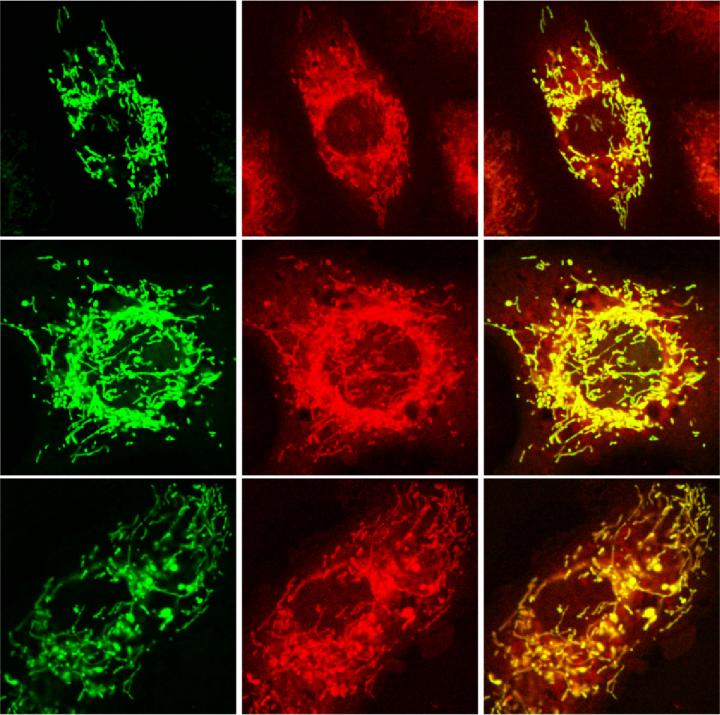

This is Sirt4 (in green) in mitochondria (in red) of cells, with asuperimposed image on right (overlap in yellow).
Credit: Jason Wood, Brown University
The results suggest that boosting Sirt4 activity may be an important avenue for treating age-related metabolic decline and disorders, such as diabetes and obesity, and promoting a healthy lifespan. The study appears in the Proceedings of the National Academy of Sciences.
“We show that Sirt4 is responsible for regulating both lifespan and metabolism in an organism, and specifically that it coordinates the metabolic response to fasting,” said lead author Jason Wood, a researcher in Brown University's Department of Molecular Biology, Cell Biology and Biochemistry. “We also demonstrate that overexpressing the gene for Sirt4 can extend lifespan of the fly.”
The genetic traits of fruit flies make them living models for exploring behavioral, development, genetic and metabolic conditions and diseases in humans.
In the study, flies modified to produce extra Sirt4 saw their healthy lifespans extended by 20 percent. Removing the ability of flies to produce Sirt4 cut their healthy lives by 20 percent. Also, without Sirt4 in their cells, flies when removed from food died rapidly, even when nutrients and fats were still present in their bodies.
Sirt4 belongs to a class of proteins, called sirtuins, known to regulate aspects of longevity, metabolism, genome stability, diabetes and neurodegeneration. Sirt4 is found in mitochondria, which are cellular structures where respiration and energy production take place.
Human cells contain seven different sirtuins, including three mitochondrial sirtuins, Sirt3, Sirt4 and Sirt5. Fruit fly cells contain just one mitochondrial sirtuin, Sirt 4. Increasing or decreasing expression of Sirt4 in living flies allowed the researchers to discover what function Sirt4 played in the insects — and possibly in humans.
“We show for the first time that increasing the activity of a mitochondrial sirtuin can extend lifespan,” Wood said. “No previous research has found that increasing the activity of a mitochondrial sirtuin such as Sirt4 extends the healthy lifespan of a living organism.”
The study also shows Sirt4 may be a gene responsible for the metabolic action of fasting, particularly the gene vital to regulating when an organism switches from carbs to fat. A creature that lacks the gene starves to death much more rapidly than normal under poor nutritional conditions.
Sirt4 is involved in the “fuel switch” during fasting, said Stephen Helfand, a professor of biology at Brown and senior author of the study. “Without Sirt4, the fly cannot access many of the nutrients and stored fats when fasting.”
Researchers know that temporary fasting in a living organism is valuable in resetting its metabolism. Such findings gave rise to what are called “near-starvation” diets to improve health and extend lifespan.
But scientists don't know how that fasting-to-reverse-aging mechanism works. Sirtuins likely play a role, Helfand said. “We want to understand more about the role of sirtuins and their involvement in pathways of calorie restriction.”
The findings serve as a starting point for explaining how Sirt4 works, Wood said. He was part of previous research on the sirtuin activator, resveratrol, linked to the slowing of aging and fighting illnesses such as cancer and diabetes. Research suggests that resveratrol activates the protein Sirt1. Now, the researchers want to know what activates Sirt4.
“We think Sirt4 is an attractive target to help improve diseases of metabolism and possibly extend healthy life,” said Helfand. “In living flies, we saw that it worked, but we're not sure how.”
Studies in mammalian cells and tissues have produced conflicting results on how mitochondrial sirtuins affect overall metabolism in mammals, Helfand added. The fruit fly has just one mitochondrial sirtuin, offering a “clear, focused ability to disrupt that one protein,” he said. “This provides us with a direct approach for assessing the major functions of mitochondrial sirtuins.”
This study was based “on a whole-animal model,” said Wood. “We could see what happened in the living fly after we deactivated or overexpressed a gene.”
###
Funding for the study came from an Ellison/American Federation for Aging Research (AFAR) Postdoctoral Fellowship Award, Nathan Shock Center Pilot Grant, Glenn/AFAR Breakthroughs in Gerontology Award, NIH Program Project Grant, and two grants from the National Institute on Aging.
Other authors include Priyan C. Wickremesinghe, Davis A. Hartnett, Lucas Burhenn and Meyrolin Garcia of Brown University; Bjoern Schwer of the University of California, San Francisco; and Eric Verdin, of the University of California, San Francisco and the Buck Institute for Research on Aging.















